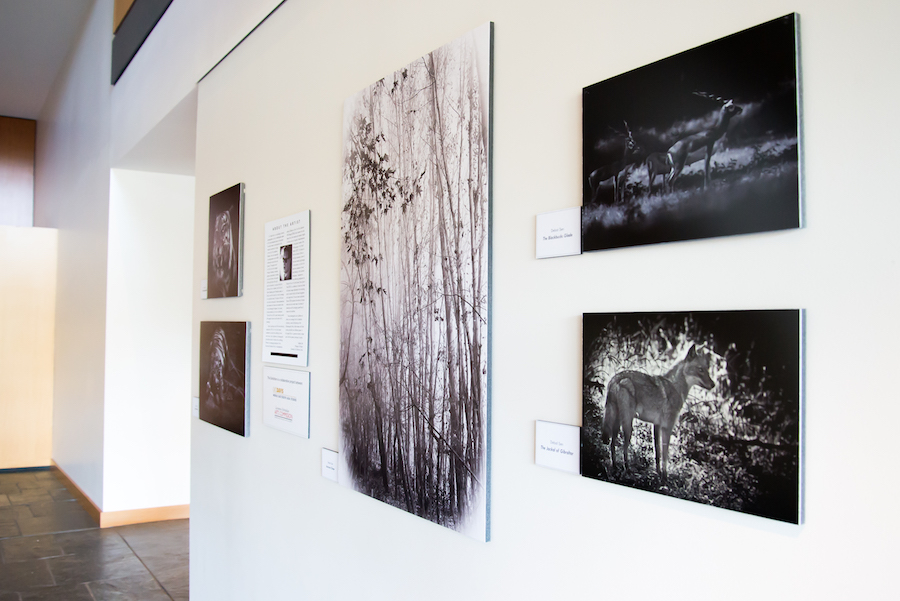
Sen brings places, animals, people out of immediate reach
Kolkata-based wildlife and nature photographer Dr. Debal Sen presented his work, “Land, Water, and Rock,” on Sept. 29 at the Mondavi Center at its opening reception. Hanumantha Rao Unnava, the dean of the UC Davis School of Management, gave a speech to kick off the event. He ended with a poignant anecdote about a colleague.
Due to the poverty that afflicts a large population of India, toys, like kites, are only available to the few who can afford them. The child who has one is considered “king,” which often entails sharing the kite (for a minimal amount of time) with the other kids. Unnava’s colleague, recognizing the polarization of kite owners, bought a whole group of children their own kites. He recalled fondly the children’s shrieks of happiness in each owning their own kite — one that didn’t have to be shared.
This story was shared, among many reasons, to exemplify the characteristics of South Asian culture. This story of the children and their kites was an appropriate way to preface Sen’s presentation of his work. In his own speech, Sen explained that his photography similarly masters the heart that embodies the region.
“Land, Water and Rock” is a part of the larger South Asia Without Borders initiative put on by the UC Davis Middle East/South Asia Program. The program, designed to highlight the region in today’s greater global context, emphasizes the potential, the creativity, the vast landscape, the beauty and the centralized culture of the region. With its clear mastery of the art and its spot-on connection to the initiative itself, Sen’s photography collection of Himalayan and South Asian nature scenes sets a high standard for the rest of the program’s events.
While specific to the subject of nature, “Land, Water, and Rock” pushes boundaries, capturing the essence of the area as a whole. The diversity of wildlife and the grandeur of the natural landscape are unique to the region, and Sen’s work presents such details to the viewers in a personal manner. From scenes of cranes departing from great bodies of water to a tiger seated regally in the jungle, the multiplicity of natural landscapes and creatures found in this single region is amazing. More surprising is that this work is only a small collection of what embodies the area. In Sen’s work, South Asia is limitless.
Furthermore, there is a sense of disillusion and disorientation with the collection, as the photographs are in black and white. The play with lighting and the intense chiaroscuro brings attention to intricate details of both animals and mountain landscapes. With such a technique, the viewer cannot distinguish light, time of day or even season. The area thus feels otherworldly — an area in which a full understanding has yet to be discovered.
Going beyond the collection, the opening reception allowed the photographer to display more of his work that was not part of the collection. Sen’s photos are physical proof of his mastery of the subject as well as his connection to the region. A personal favorite photograph includes a mountain night scene — bright stars over the dark silhouette of mountains in the foreground. The stark contrast and the elemental harmony makes the viewer wonder how grand the scene would be in person.
Sen also presented photographs of indigenous peoples and places of worship that he found serendipitously on his hiking trails — small tribes in their daily routines and stone relics among a mountainous landscape. These photographs, with stunningly balanced composition, further show the diversity and idiosyncrasy of the region through nature and its human inhabitants.
Sen is thus not just a photographer of nature, but of portraits as well. Likewise, he is not just a photographer, but a true adventurer. The often dangerous ways in which Sen took these photographs adds an extra layer of depth to the experience. He has called his collection “some of [his] fondest memories of the last 60 years,” which is truly no surprise. Through his photography, Sen has climbed 18,000-foot summits, carrying all necessary food and camera equipment.
Because of this, the camera he uses isn’t as important as what can fit in his pack. His photographs, which are complex, yet balanced and extremely detailed, are therefore not a reflection of technology, but rather of his abilities as a photographer. Sen has also demonstrated his skills as a cultural middleman.
There is a paradoxical aspect of “Land, Water, and Rock”: the vast diversity of the area becomes personal and close to the viewer, yet it is simply just a taste. There truly is more than meets the eye. But that’s the point; there is still so much to discover outside the confines of our region of the world. There are areas of immense beauty — ones that embody vastly different landscapes — that also deserve the same amount of recognition and admiration. “Land, Water, and Rock” sparks further exploration from the viewer; an area of this greatness deserves as much.
“Land, Water, and Rock” will be on display in the Mondavi Center Lobby from Sept. 29 to Nov. 1 free of charge.
Written by: Caroline Rutten — arts@theaggie.org



